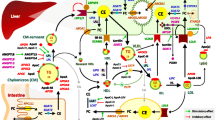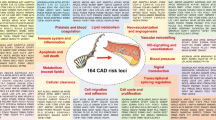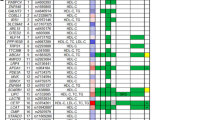Summary
In order to elucidate the genetic abnormalities underlying lipoprotein disorders associated with coronary heart disease susceptibility, researchers have looked for candidate genes. The studies have focused particularly on the lipoprotein transport genes. Relatively common as well as rare mutations have already been identified in several of these genes. In addition, further metabolic and genetic studies indicate that some of these loci harbor significant, but as yet undefined, genetic variation. In the next few years, it is not unreasonable to expect that all or most of the significant mutations at these loci will be catalogued. It is too early to know whether this will be sufficient to explain the genetic basis of altered lipoprotein levels or whether new loci will need to be investigated. Additional candidate gene loci might be those coding for genes involved in intracellular cholesterol metabolism, cholesterol absorption, or insulin resistance. New loci may also be revealed by the technique of reverse genetics. A more complete understanding of the genetics of atherosclerosis susceptibility will probably also entail the identification of variants at genetic loci that control both the reaction of the blood vessel wall to atherogenic lipoproteins and the thrombosis system. Investigation of the genetic basis of coronary heart disease susceptibility remains a worthwhile and lively field, with important clinical and public health ramifications.
Similar content being viewed by others
Abbreviations
- LPL:
-
lipoprotein lipase
- HL:
-
hepatic lipase
- LCAT:
-
ecithin cholesteryl acyltransferase
- CETP:
-
cholesteryl ester transfer protein
- RFLP:
-
restriction fragment length polymorphism
- FCR:
-
fractional catabolic rate
- HDL, LDL, VLDL, SDL:
-
high, low, very low, intermediate density lipoproteins
References
Aalto-Setala K, Helve E, Kovanen RT, Kontula K (1989) Finnish type of low density lipoprotein receptor gene mutation (FH-Helsinki) deletes exons encoding the carboxy-terminal part of the receptor and creates an internalization-defective phenotype. J Clin Invest 84:499–505
Berg K (1963) A new serum type system in man: the Lp system. Acta Pathol Microbiol Scand 59:369–382
Blackhart BD, Ludwig EM, Pierotti VR, Caiati L, Onasch MA, et al (1986) Structure of the human apolipoprotein B gene. J Biol Chem 261:15364–15367
Breslow JL (1989) Familial disorders of high density lipoprotein metabolism. In: Scriver CR, Beaudet AL, Sly WS, Valle D (eds) The metabolic basis of inherited disease, 6th edn. McGraw-Hill, New York, pp 1251–1266
Breslow JL (1991) Lipoprotein transport gene abnomalities underlying coronary heart disease susceptibility. Annu Rev Med 42:357–371
Brinton EA, Eisenberg S, Breslow JL (1989) Elevated high density lipoprotein cholesterol levels correlate with decreased apo A-I and apo A-II fractional catabolic rate in women. J Clin Invest 84:262–269
Brinton EA, Eisenberg S, Breslow JL (1990) A low fat diet decreases HDL-cholesterol levels by decreasing HDL apolipoprotein rates. J Clin Invest 85:144–151
Brinton EA, Eisenberg S, Breslow JL (1991) Increased apo A-I and apo A-II fractional catabolic rate in patients with low HDL-cholesterol levels with or without hypertriglyceridemia. J Clin Invest 87:536–544
Brown ML, Inazu A, Hesler CB, Agellon LB, Mann C, et al (1989) Molecular basis of lipid transfer protein deficiency in a family with increased high-density lipoproteins. Nature 342:448–451
Chen S-H, Habib E, Yang C-Y, Gu Z-W,, Lee BR, et al (1987) Apolipoprotein B-48 is the product of a messenger RNA with an organ-specific in-frame stop codon. Science 238:363–366
Connelly PW, Maguire GF, Lee M, Little JA (1990) Plasma lipoproteins in familial hepatic lipase deficiency. Arteriosclerosis 10:40–48
Cortner JA, Coates PM, Le NA, Cryer DD, Ragni MC, et al (1987) Kinetics of chylomicron remnant clearance in normal and hyperlipoproteinemic subjects. J Lipid Res 28:195–206
Dahlen GH, Guyton JR, Attar M, Farmer JA, Kautz JA, et al (1986) Association of levels of lipoprotein Lp(a), plasma lipids, and other proteins with coronary artery disease documented by angiography. Circulation 74:758–765
Das HK, McPherson J, Bruns GAP, Karathanasis SK, Breslow JL (1985) Isolation, characterization and mapping to chromosome 19 of the human apolipoprotein E gene. J Biol Chem 260:6240–6247
Davignon J, Gregg RE, Sing CF (1988) Apolipoprotein E polymorphism and athersoclerosis. Arteriosclerosis 8:1–21
Demant T, Carlson LA, Holmquist L, Karpe F, Nilsson-Ehle P, et al (1988) Lipoprotein metabolism in hepatic lipase deficiency: studies on the turnover of apolipoprotein B and on the effect of hepatic lipase on high density lipoprotein. J Lipid Res 29:1603–1611
Eckardstein A von, Funke H, Henke A, Altland K, Benninghoven A, et al (1989) Apolipoprotein A-I variants: naturally occurring substitutions of proline residues affect plasma concentration of apolipoprotein A-I. J Clin Invest 84:1722–1730
Eckardstein A von, Funke H, Walter M, Altland K, Benninghoven A, et al (1990) Structural analysis of human apolipoprotein A-I variants. J Biol Chem 265:8610–8617
Eisenberg S (1984) High density lipoprotein metabolism. J Lipid Res 25:1017–1058
Farese RV Jr, Linton MF, Young SG (1991) Apolipoprotein B gene mutations affecting cholesterol levels. J Int Med (in press)
Fojo S, Brewer HB Jr (1992) Hypertriglyceridemia due to genetic defects in lipoprotein lipase and apolipoprotein C-II. J Int Med (in press)
Franceschini G, Sirtori CR, Capurso A, Weisgraber KH, Mahley RW (1980) AIMilano apoprotein. Decreased high density lipoprotein cholesterol levels with significant lipoprotein modifications and without clinical atherosclerosis in an Italian family. J Clin Invest 66:892–900
Gaubatz JW, Heideman C, Gotto AM Jr, Morrisett JD, Dahlen GH (1982) Human plasma lipoprotein(a): structural properties. J Biol Chem 258:4582–4589
Gavish D, Azrolan N, Breslow JL (1989) Plasma Lp(a) concentration is inversely correlated with the ratio of Kringle IV/Kringle V encoding domains in the apo(a) gene. J Clin Invest 84:2021–2027
Goldstein JL, Brown MS (1989) Familial hypercholesterolemia. In: Scriver CR, Beaudet AL, Sly VS, Valle D (eds) The metabolic basis of inherited disease, 6th edn. McGrawHill, New York, pp 1215–1250
Havel JH, Kane JP (1989) Lipoprotein and lipid metabolism disorders. Introduction: structure and metabolism of plasma lipoproteins. In: Scriver CR, Beaudet AL, Sly WS, Valle D (eds) The metabolic basis of inherited disease, 6th edn. McGraw Hill, New York, pp 1129–1138
Hobbs HH, Brown MS, Russell DW, Davignon J, Goldstein JL (1987) Deletion in the gene for the low-density-lipoprotein-receptor in a majority of French Canadians with familial hypercholesterolemia. N Engl J Med 317:734–737
Huang L-S, Miller DA, Bruns GAP, Breslow JL (1986) Mapping of the human apo B gene to chromosome 2p and demonstration of a two allele RFLP. Proc Natl Acad Sci USA 83:644–648
Huang L-S, Ripps ME, Korman SH, Deckelbaum RJ, Breslow JL (1989) Hypobetalipoproteinemia due to an apolipoprotein B gene exon 21 deletion derived by Alu-Alu recombination. J Biol Chem 264:11394–11400
Innerarity TL, Weisgraber KH, Arnold KS, Mahley RW, Krauss RM, et al (1987) Familial defective apolipoprotein B-100: low density lipoproteins with abnormal receptor binding. Proc Natl Acad Sci USA 84:6919–6923
Ito Y, Azrolan N, O'Connell A, Walsh A, Breslow JL (1990) Hypertriglyceridemia as a result of human apolipoprotein CIII gene expression in transgenic mice. Science 249:790–793
Karathanasis SK (1985) Apolipoprotein multigene family: tandem organization of human apolipoprotein AI, CIII, and AIV genes. Proc Natl Acad Sci USA 82:6374–6378
Karathanasis SK, Zannis VI, Breslow JL (1983) Isolation and characterization of the human apolipoprotein A-I gene. Proc Natl Acad Sci USA 80:6147–6151
Karathanasis SK, McPherson J, Zannis VI, Breslow JL (1983) Linkage of human apolipoprotein A-I and C-III genes. Nature 304:371–373
Karathanasis SK, Norum RA, Zannis VI, Breslow JL (1983) An inherited polymorphism in the human apolipoprotein A-I gene locus related to the development of atherosclerosis. Nature 301:718–720
Karathanasis SK, Zannis VI, Breslow JL (1983) A DNA insertion in the apolipoprotein A-I gene locus related to the development of atherosclerosis. Nature 305:823–825
Karathanasis SK, Ferris E, Haddad IA (1987) DNA inversion within the apolipoprotein AI/CIII/AIV-encoding gene clusters of certain patients with premature atherosclerosis. Proc Natl Acad Sci USA 84:7198–7202
Koizummi JH, Mabuchi A, Yoshimura I, Michishita M, Takeda H, et al (1985) Deficiency of serum cholesteryl-ester transfer activity in patients with familial hyperalphalipoproteinemia. Atherosclerosis 58:175–186
Kurasawa T, Yokoyama S, Miyake Y, Yamamura Y, Yamamato A (1985) Rate of cholesteryl ester transfer between high and low density lipoproteins in human serum and a case with decreased transfer rate in association with hyperalphalipoproteinemia. J Biochem 98:1499–1508
Lackner C, Boerwinkle E, Leffert CC, Rahmig T, Hobbs HH (1991) Molecular basis of apolipoprotein(a) isoform size heterogeneity as revealed by pulsed-field gel electrophoresis. J Clin Invest 87:2153–2161
Lehrman MA, Schneider WJ, Brown MS, Davis CG, Elhammer A, et al (1987) The Lebanese allele at the LDL receptor locus: nonsense mutation produces truncated receptor that is retained in endoplasmic reticulum. J Biol Chem 262:401–410
Leitersdorf E, Westhuyzen DR Van Der, Coetzee GA, Hobbs HH (1989) Two common low density lipoprotein receptor gene mutations cause familial hypercholesterolemia in Afrikaners. J Clin Invest 84:954–961
Leitersdorf E, Tobin EJ, Davignon J, Hobbs HH (1990) Common low-density lipoprotein receptor mutations in the French Canadian population. J Clin Invest 85:1014–1023
Leppert M, Breslow JL, Wu L, Hasstedt S, O'Connell P, et al (1988) Inference of a molecular defect of apolipoprotein B in hypobetalipoproteinemia by linkage analysis in a large kindred. J Clin Invest 82:847–851
The Lipid Research Clinics Population Studies Data Book (1980) The prevalence study, vol 1. (NIH publ. 80–1527) US Dept Health and Human Services, Natl Inst Health, Bethesda
Mahley RW, Rall SC Jr (1989) Type III hyperlipoproteinemia (dysbetalipoproteinemia): the role of apolipoprotein E in normal and abnormal lipoprotein metabolism. In: Scriver CR, Beaudet AL, Sly WS, Valle D (eds) The metabolic basis of inherited disease, 6th edn. McGraw-Hill, New York, pp 1195–1213
Matsunaga T, Hiasa Y, Yanagi H, Maeda T, Hattori N, Yamakawa K, Yamanouchi Y, Tanaka I, Obara T, Hamaguchi H (1991) Apolipoprotein A-I deficiency due to a codon 84 nonsense mutation of the apolipoprotein A-I gene. Proc Natl Acad Sci USA 88:2793–2797
McLean JW, Tomlinson JE, Kuang W-J, Eaton DL, Chen EY, et al (1987) cDNA sequence of human apolipoprotein(a) is homologous to plasminogen. Nature 330:132–137
Nichols WC, Dwulet FE, Liepnicks J, Benson MD (1988) Variant apolipoprotein AI as a major constituent of a human hereditary amyloid. Biochem Biophys Res Commun 156:762–768
Norum RA, Lakier JB, Goldstein S, Angel A, Goldberg RB, et al (1982) Familial deficiency of apolipoproteins A-I and C-III and precocious coronary artery disease. N Engl J Med 306:1513–1519
Norum KR, Gjone E, Glomset JA (1989) Familial lecithin: cholesterol acyltransferase deficiency including fish eye disease. In: Scriver CR, Beaudet AL, Sly WS, Valle D (eds) The metabolic basis of inherited disease, 6th edn. McGraw-Hill, New York, pp 1181–1194
Ordovas JM, Cassidy DK, Civeira F, Bisgaier CL, Schaefer EJ (1989) J Biol Chem 264:16339–16342
Paik YK, Chang DJ, Reardon CA, Davies GE, Mahley RW, et al (1985) Nucleotide sequence and structure of the human apolipoprotein E gene. Proc Natl Acad Sci USA 82:3445–3449
Powell LM, Wallis SC, Pense RJ, Edwards YH, Knott TJ, et al (1987) A novel form of tissue-specific RNA processing produces apolipoprotein B-48 in intestine. Cell 50:831–840
Rall SC, Weisgraber KH, Mahley RW (1981) Human apolipoprotein E. J Biol Chem 257:4171–4178
Rhoads GG, Dahlen G, Berg K, Morton NE, Dannenberg AL (1986) Lp(a) lipoprotein as a risk factor for myocardial infarction. J Am Med Assoc 256:2540–2544
Scanu A (1990) Lipoprotein(a): heterogeneity and biological relevance. J Clin Invest 85:1709–1715
Schaefer EJ, Heaton WH, Wetzel MG, Brewer HB Jr (1982) Plasma apolipoprotein A-I absence associated with a marked reduction of high density lipoproteins and premature coronary artery disease. Arteriosclerosis 2:16–26
Schmitz G, Lackner K (1989) In: Crepaldi G, Gotto AM, Manzato E, Baggio G (eds) Atherosclerosis, vol 8. Excerpta Medica, Amsterdam, pp 399–403
Schmitz G, Assmann G, Robenek H, Brennhausen B (1985) Tangier disease: a disorder of intracellular membrane traffic. Proc Natl Acad Sci USA 82:6305–6309
Schneider WJ, Kovanen PT, Brown MS, Goldstein JL, Utermann G, et al (1981) Familial dysbetalipoproteinemia. Abnormal binding of mutant apoprotein E to low density lipoprotein receptors of human fibroblasts and membranes from liver and adrenals of rats, rabbits, and cows. J Clin Invest 68:1075–1085
Shaefer EJ, Blum CB, Levy RI, Jenkins LL, Alaupovic P, et al (1978) Metabolism of high density lipoprotein apolipoproteins in Tangier disease. N Engl J Med 299:905–910
Shoulders CC, Kornblihtt AR, Munro BS, Baralle FE (1983) Gene structure of human apolipoprotein AI. Nucleic Acids Res 11:2827–2837
Soria LF, Ludwig EH, Clarke HRG, Vega GL, Grundy SM, et al (1989) Association between a specific apolipoprotein B mutation and familial defective apolipoprotein B-100. Proc Natl Acad Sci USA 86:587–591
Sudhof TC, Goldstein JL, Brown MS, Russell DW (1985) The LDL receptor gene: a mosaic of exons shared with different proteins. Science 228:815–822
Utermann G (1989) The mysteries of lipoprotein(a). Science 246:904–910
Utermann G, Weber W (1983) Protein composition of Lp(a), lipoprotein from human plasma. FEBS Lett 154:357–361
Utermann G, Menzel HJ, Kraft HG, Duba HC, Kemmler HG, et al (1987) Lp(a) glycoprotein phenotypes: inheritance and relation to Lp(a)-lipoprotein concentrations in plasma. J Clin Invest 80:458–465
Vega GL, Grundy SM (1986) In vivo evidence for reduced binding of low density lipoproteins to receptors as a cause of primary moderate hypercholesterolemia. J Clin Invest 78:1410–1414
Weintraub MS, Eisenberg S, Breslow JL (1987) Dietary fat clearance in normal subjects is regulated by genetic variation in apolipoprotein E. J Clin Invest 80:1571–1577
Weintraub MS, Eisenberg S, Breslow JL (1987) Different patterns of postprandial metabolism in normals, and type IIa, type III and type IV hyperlipoproteinemics. Effects of treatment with cholestyramine and gemfibrozil. J Clin Invest 79:1110–119
Weisgraber KH, Rall SC Jr, Bersot TP, Mahley RW (1983) Apolipoprotein AIMilano. Detection of normal A-I in affected subjects and evidence for a cysteine for arginine substitution in the variant A-I. J Biol Chem 258:2508–2513
Zannis VI, Breslow JL (1981) Human VLDL apo E isoprotein polymorphism is explained by genetic variation and post-translational modification. Biochemistry 20:1033–1041
Zannis VI, Just PW, Breslow JL (1981) Human apolipoprotein E isoprotein subclasses are genetically determined. Am J Hum Genet 33:11–24
Zannis VI, Breslow JL, Utermann G, Mahley R, Weisgraber KH, et al (1982) Proposed nomenclature of apo E isoprotein genotypes and phenotypes. J Lipid Res 23:911–914
Author information
Authors and Affiliations
Rights and permissions
About this article
Cite this article
Breslow, J.L. Apolipoprotein genes and atherosclerosis. Clin Investig 70, 377–384 (1992). https://doi.org/10.1007/BF00235516
Received:
Accepted:
Issue Date:
DOI: https://doi.org/10.1007/BF00235516




